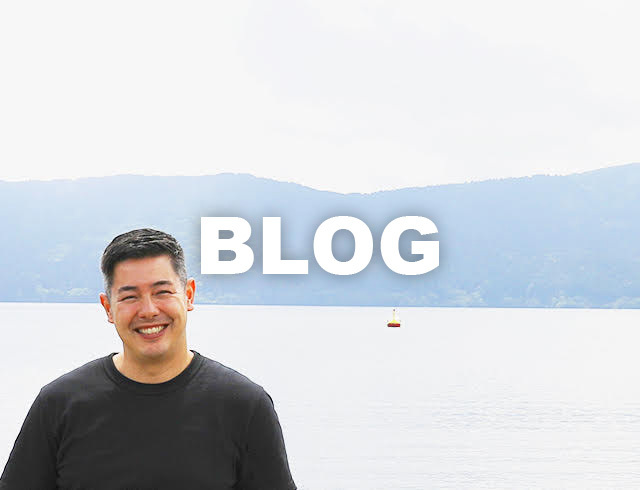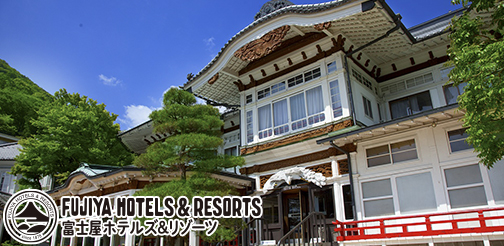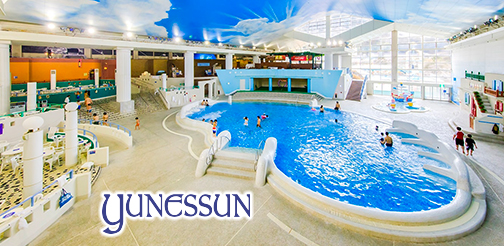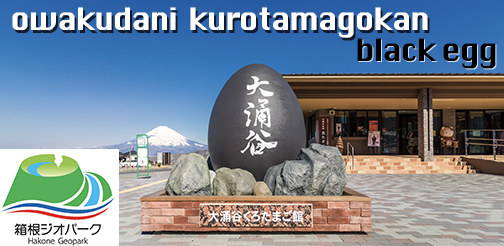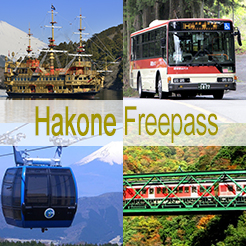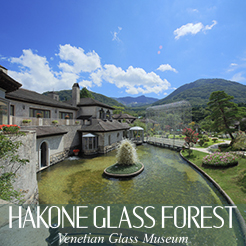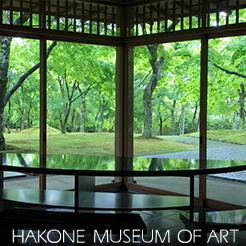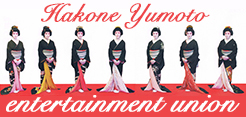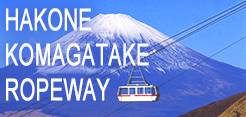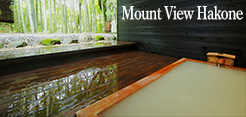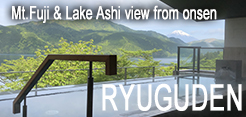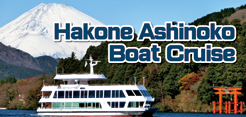On July 15, 1878, the Fujiya Hotel was opened in Miyanoshita, Hakone. At the time of its opening, Miyanoshita was still a peaceful village in the mountains of Hakone. Hakone is about 90km SW of Tokyo. Inside the Fujiya Hotel, there is still a painting depicting Miyanoshita and the Fujiya Hotel at the time of its establishment. It was drawn by a British-born trader named C. B. Barnard, who had been a customer of Fujiya Hotel for over 60 years since its establishment.
Thatched houses are lined up along the slope of the mountain, with rice fields in the foreground. Behind the thatched roofs stands a Western-style building, which is the Fujiya Hotel.
The current location of the inn was acquired from Fujiya, a historic inn with 500 years of history, and it was Sennosuke Yamanguchi’s marketing strategy to change the Japanese language written characters for the word Fujiya. The name change was from 藤屋, Wisteria Room” to 富士屋 “Mt. Fuji Room.” But, the Fujiya Hotel is not facing the direction of Mt. Fuji or visible from the hotel. “Well, it’s located in Hakone, why do they put “Fuji ” in the name of the hotel if you can’t see Mt. Fuji is a question asked very often.
Well, there is now Fuji-Hakone-Izu National Park, and some guidebooks are published under the heading of “Fuji-Hakone,” so it may not be so strange for a hotel in Hakone to have the name “Fuji” on it. And the famous mountain is quite close, but is hidden by some of the Hakone mountains.
However, this national park was designated on February 1, 1936, so it’s been a long time since it was opened~. So there may have been many people who felt uncomfortable at the time.
But then again, it’s not as if the Fujiya Hotel had no connection with Mt. Fuji. When the hotel first opened in the Meiji era (1868-1912), there were no hotels for foreigners around Mt. Fuji, so there were many people who used the Fujiya Hotel as a base for climbing Mt. Fuji, the Fuji View Hotel was built by Lake Kawaguchi, and the Fruit Park Fujiya Hotel opened in Fuefukigawa Fruit Park.
When the Fujiya Hotel opened in 1878, it was open to both Japanese and foreigners. However, Sennosuke had the idea that “the hotel business was a way to earn foreign currency.” Sennosuke was an entrepreneur and was unusual in that he had experience abroad. He knew the value of foreign guests and understood the differing needs they may have from the services traditional Japanese inns provided.
“The purpose of Fujiya Hotel is to collect money from foreigners. Taking money from the Japanese is like a child taking money from his parents. My purpose is to import pure foreign gold coins. There is no need for Japanese guests to come.”
Quoted from “Eighty Years of Fujiya Hotel History”.
It was in 1893 that the Fujiya Hotel became a hotel specializing in foreigners, and it was because of the “Agreement on Lodging Business” signed with the Naraya Hotel located across the street in Miyanoshita, Hakone.
Naraya was the first ryokan to accept foreigners before Fujiya, and it had an even older history than Fujiya Hotel. It was founded in the early Edo period, and from the mid to late Edo period, it was the main inn where many feudal lords stayed, and the Emperor and Empress Meiji stayed there in the past.
The Fujiya Hotel was established near there in 1878, and the two hotels became rivals. Fujiya paid a certain amount of money to Naraya every year, so Fujiya became a foreigner’s inn and Naraya became a Japanese inn. This contract continued until the first year of the Taisho Era (1912), so there was a period of about 20 years when the Fujiya Hotel was exclusively for foreigners!
Although the Naraya Hotel was a rival to the Fujiya Hotel, it is now closed, but the son of the hotel owner has opened a cafe called “NARAYA CAFE” just outside Miyanoshita Station. The cafe offers wonderful drinks, nice views, foot baths, and even displays items from the Naraya Hotel.
It may also be important to talk about the connection with “Kanaya Hotel”, another very famous hotel in Nikko that also catered to foreigners during the time when the exposure to the outer world was very limited for many Japanese.
The predecessor of the Kanaya Hotel in Nikko was the Kanaya Cottage Inn, the first foreigner-only resort hotel in Japan, and its building is now a museum. Kanaya Hotel is a long-established hotel that is still in business in Nikko, and like Fujiya, it is a pioneer of resort hotels in Japan.
Sennosuke’s eldest son, Shuichiro, was completely unsuited to the management of a hotel, and he was trying to get his eldest daughter, Takako, to take charge of Fujiya with a suitable person, so he set his eyes on the second son of Kanaya. In December 1907, Sennosuke Yamaguchi adopted Shozo, the second son of Zenichiro Kanaya, the founder of Fujiya, from the Kanaya Hotel in Nikko, as the son-in-law of his eldest daughter Takako.
After that, Shozo took over the management of the hotel, but Sennosuke and Shozo often clashed due to differences in opinion. For example, their views on hot springs.
Sennosuke: “I don’t like to aggressively promote the benefits of hot springs. If we advertise too much, won’t Fujiya turn into a sanatorium for sick people?
Shozo: “No, no, no, it’s a blessing of nature, and we should actively use it!
There was a clash of opinions, but Shozo took the liberty of using the hot spring to build a greenhouse. Shozo seemed to like flowers. Even though he built it without permission, Sennosuke was rather positive when he saw the plants blooming in the greenhouse, saying, “Oh, that’s nice! He was rather pleased with the decision.
It seems that guests were not allowed to enter this greenhouse, but now all the flowers that decorate the guest rooms and dining tables are grown in the greenhouse and it is open to visitors now. It seems that Shozo was particularly fond of orchids, and he grew a wide variety of them here, including primroses and rare insectivorous plants.They also have a collection of insectivorous plants! This greenhouse was the first place where Shozo reflected his own opinions in Fujiya, and his dreams were reflected in Fujiya from here.
Shozo’s next new venture was the car. It was at the end of the Meiji era that automobiles became common as a form of public transportation. At that time, foreigners began to arrive by private car using the Route 1 laid out by Sennosuke.
Until then, the most common vehicles in Hakone were rickshaws and chairs carried by porters. A chair, as you can see in the photo above, is a chair with four carrying bars attached. After talking to his brother and friends to gather funds, he established Fujiya Motor Company in 1914.
At first, the company specialized in chartered cars, but in 1919, it started operating passenger cars, or buses as we know them today. The cars, painted red to make them stand out, were very popular and were called “Fujiya lunch boxes” because of their shape. The Fujiya Motorcar Company changed its name and became the Hakone Tozan Bus, which is still in operation today. In Hakone today, traces of Shozo continue to remain in various forms.
Fujiya Hotel has a connection with the Kanaya Hotel in Nikko, but Fujiya also has a connection with the Imperial Hotel, a very famous hotel in Tokyo.
The Imperial Hotel, which opened in 1890, was in urgent need of a new building since the end of the Meiji era. However, the construction period and budget were greatly exceeded, and fires broke out twice, in 1919 and 1924. This led to the resignation of Kihachiro Okura and the departure of Aisaku Hayashi, the manager at the time. That’s when Shozo was chosen to run the hotel. There were many connections between these famous hotels. Shozo was the manager of the hotel for ten months then returned to Hakone. In 1967, the building was dismantled and the entrance designed by Frank Lloyd Wright was moved to Meiji-mura in Aichi Prefecture.
Shozo later completed the construction of the dining hall, his first large-scale building. It is still in use today as the restaurant “The Fujiya,” serving French cuisine. Although the Fujiya Hotel building is filled with a western atmosphere, Shozo used this building as a starting point to develop a series of buildings with a Japanese design theme. The ceilings are very high and lattice-like, reminiscent of shrine buildings, and each of them has alpine plants painted on it, etc. Looking around, you can catch a glimpse of various particulars.
Around 1969 or 1970, there was a growing demand in the hotel industry as well as in the inn industry for an institution to educate hotel staff. Therefore, the Fujiya Training School was established to provide education with a well-designed curriculum.
This school finished its role after about ten years, but its will actually remains in the Tourism Department of Rikkyo University. Actually, this department was created after Shozo’s death, when the incense collected at his funeral was donated to Rikkyo University.
It’s so interesting to find out about a single hotel like this and see how it leads to many different stories and has an impact on an entire industry for one country.
The restaurant “The Fujiya” was built in 1930, and after that, the Fujiya Hotel kept getting bigger and bigger welcoming a wide array of guests from around the world.
The new building, Hana Goten (Flower Palace), was built on June 10, 1936, which mainly consists of guest rooms with baths. Shozo was also responsible for this design. The 43 guest rooms were named after flowers instead of room numbers (now the numbers are used together), the doors of the rooms were decorated with those flowers, and the room keys were huge wooden key chains with the same picture on them. An indoor pool using hot spring water was also built in the basement of the Hana Goten!
After that, the Fuji View Hotel opened on the shores of Lake Fuji Five Lakes, and the Hakone Golf Club was established, followed by the Sengokuhara Golf Course, which was taken over by Fujiya.
In the 1940s, the Pacific War broke out and Japan lost the war. Therefore, the Fujiya Hotel, as well as many other inns and hotels, had to be confiscated. Not only that, but in February 1944, during the war, Shozo, who had worked on the Fujiya Hotel, died. Shozo was succeeded by Kenkichi, who was adopted as a son-in-law by Sennosuke’s second daughter Sadako.
After the war, the Occupation Forces came to Fujiya Hotel and confiscated it, but Fujiya seemed to be a hotel that welcomed the Occupation Forces favorably. It became a popular place for high ranking officials to stay, including Dwight Eisenhowser and Douglas Mac Arthur. The Fujiya Hotel’s unique Japanese style building, high level of service, and operational management, and mountain location were highlights for the visiting forces. Since Shozo’s time, he had paid more attention to cleaning than most people, and was rarely pointed out for his high level of personal hygiene and care.
Kenkichi accepted the seizure of the hotel and treated the Occupation forces mildly, and the seizure was completed without any major incident and handed back to the family.
Later, on July 6, 1954, after eight years and eight months of confiscation, the restaurant reopened for business. However, Kenkichi’s heart was filled with anxiety. There were many people who could not be contacted under the new post-war system, and he wondered if the customers would come back.
Although there were days of struggle, by 1958, the year Fujiya Hotel celebrated its 80th anniversary, things took a turn for the better and the direction of management became clear. In the previous year or so, the fever for sightseeing in Japan had been growing in Europe and the United States, and luxury cruise ships around the world began to call at Japan one after another, and many of the passengers went to Hakone from Tokyo and the port city of Yokohama.
In 2018, the hotel underwent a major renovation, and after two years of construction, it reopened for business in July 2020. As of 2021, Fujiya Hotel will have been in business for 143 years and we look forward to what history the future holds for this iconic landmark in Hakone.

